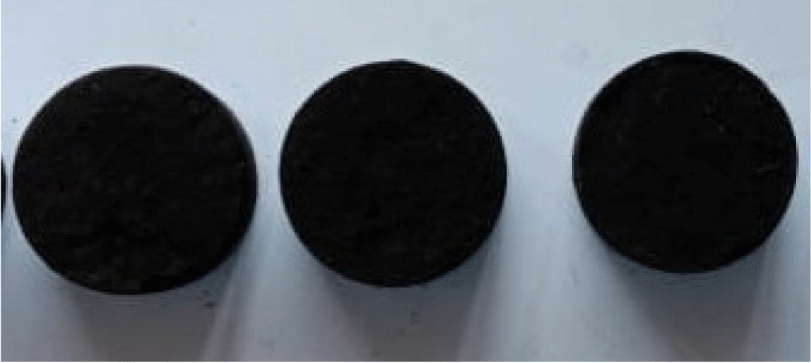1. INTRODUCTION
Rapid economic development has led to increased energy consumption, and most sectors are anticipated to continue using fossil fuels as the primary source of energy. However, fossil fuels severely harm the environment, have high emission levels, and are non-renewable. Therefore, exploring alternative non-fossil fuel energy sources is necessary. Biomass is a natural potential alternative fuel and material for producing briquettes (Coleti et al., 2020). Briquettes, particularly those produced from biomass waste, are an alternative energy source with several advantages. They are renewable, cause less pollution, and reduce greenhouse gas emissions compared with coal-based briquettes. Briquettes from biomass are considered more environmentally friendly and capable of providing energy security (Njenga et al., 2014; Teixeira et al., 2010). Generally, the order of emission and polycyclic aromatic hydrocarbon (PAH) compound production is biomass > briquettes > charcoal. The use of fuel from biomass processed through carbonization is estimated to reduce pollutants amounting to more than 600 thousand tons of PM2.5 and thousands of tons of PAH compounds (Sun et al., 2019).
Additionally, energy development based on the use of energy derived from biomass has considerable potential, especially in Indonesia where biomass raw materials are abundant. Numerous large industries, households, restaurants, and other sectors use briquettes as energy source. The development of biomass as a raw material (especially biomass waste) for briquettes also increases the value of biomass. It is cost-effective, provides investment and entrepreneurship opportunities, increases the income of communities, creates new jobs, and promotes local bioeconomy (Efiyanti et al., 2022; Hakizimana and Kim, 2016).
Coconut shells (CSs) are one type of biomass that can be used as a raw material for producing briquettes. They can be directly converted into briquettes, pellets, and charcoal or as precursors for briquette products. The potential of CSs is high, as evidenced by Indonesia’s numerous coconut plantations and considerable coconut production. Coconut plants are found from Sabang to Merauke; they grow rapidly with minimal care. These shells are wastes containing lignocellulosic materials that have numerous benefits. Coconut plants are relatively abundant in Indonesia; therefore, they can provide potential natural capital. The area of coconut plantations in Indonesia has reached 3.3 × 106 ha with a potential CS weight of 15%–19% of the total weight of the coconuts. The heating value of CSs, which contain lignin, cellulose, and hemicellulose, is 18,200–19,388.05 kJ/kg. The CSs can be converted into charcoal, which has high calorific value and adsorption capacity because of their porosity and specific surface area. The pores in charcoal can adsorb other compositions/additives for briquette formation.
Charcoal can be produced from the combustion, pyrolysis, or carbonization of biomass or carbon-containing materials at a specific temperature (generally 100°C–1,000°C) with limited oxygen. It can be prepared using a pyrolysis reactor or a kiln drum. Combustion can change raw organic materials into charcoal, releasing impurities such that the number of pores and surface area exceed those of the original raw materials. Charcoal is an eco-friendly material with a carbon content of 80%–90% (Hwang and Oh, 2021). Its production substantially impacts fuel properties (Mencarelli et al., 2022).
Briquettes are generally produced by pressing or compacting raw materials into uniform solids with low moisture and high calorific values using a hydraulic press; consequently, they can be facilely used and distributed (Nyakuma et al., 2014; Rousset et al., 2011). Briquette production typically uses additives, such as starch, molasses, clay, and tar, to maintain the shape of briquettes (Jelonek et al., 2020). Biomass briquettes generally burn more gradually than charcoal. Therefore, the composition of briquettes must be modified to improve combustion. Briquette products are widely modified using other materials, such as additives, igniters, and aromas, tailored to market demands. Pine resin is an ingredient that can be added to briquettes. It is a non-timber forest product obtained by tapping pine trunks (Hadiyane et al., 2019). Pine trees have significantly thrived in Indonesia and have become a source of superior products, including resins. Tens of tons of pine resin are produced annually in Indonesia with an average production of 30–60 kg/tree/year. Pine resin or turpentine has an aroma that can relieve stress and improve health including alleviating respiratory disorders.
Several studies have been conducted on the production of biomass charcoal briquettes. Briquettes from Idigbo wood charcoal have varying contents of pine sawdust and cassava peel as binder. These briquettes are produced using charcoal as raw material, providing a high calorific value compared with briquettes without charcoal (Ajimotokan et al., 2019). Briquettes made from Madan wood (MW) charcoal and CS with ratios (i.e., MW:CS) of 100%:0%, 80%:20%, 50%:50%, and 0%: 100% are produced to obtain a calorific value of 6,300–6,600 cal/g. Hence, these briquettes are considered as a suitable alternative fuel for households and restaurants in Thailand (Kongprasert et al., 2019). Charcoal briquettes from palm kernel shells have a calorific value of approximately 4,700 kcal/kg; they do not produce ash, odor, or sparks when combusted (Osei Bonsu et al., 2020). Otieno et al. (2022) found that the calorific values of charcoal and briquettes were 6,138 and 4,729 kcal/kg, respectively. Their research also showed that the combustion of charcoal or briquettes with charcoal produced virtually no NOx compounds. The foregoing indicates that the simultaneous combustion of briquettes and charcoal is a potential approach for safely generating sufficient heat for households. The foregoing indicates that research on the production of briquette charcoal with 0%–30% pine resin has yet to be conducted. Accordingly, in this study, charcoal briquettes with added pine resin (API) briquettes are produced; CS charcoal is used, and pine resin is the source of ignition and aroma.
2. MATERIALS and METHODS
The materials used in this study are CSs from North Maluku, tapioca, distilled water, and pine resin. The equipment used includes a pyrolysis reactor, a set of glassware, a briquette hydraulic presser, a desiccator, an oven, a furnace, a crucible, a 60-mesh sieve, an analytical balance, a bomb calorimeter, a universal testing machine, and a pyrolysis gas chromatography–mass spectrometry (py-GCMS) apparatus (Shimadzu, Kyoto, Japan).
The charcoal production from CSs begins with the preparation of raw materials. To minimize the moisture content of the material, the CSs were dried. Furthermore, the shell was burned for several hours through conventional combusting using a kiln drum until smoke emission stopped, producing CS charcoal. This charcoal was then used as the main component of the API briquettes.
The production of API briquettes begins by preparing a charcoal precursor. Then, starch and water are mixed until the combination thickens and becomes clear in appearance; the starch concentration is 7%. The next step is to blend the pine resin and starch in water obtained from the previous step until they are homogeneous. Subsequently, charcoal is combined with the mixture of pine resin and starch adhesive. The variations in the amount of pine resin added to charcoal are 0%, 0.5%, 1%, 1.5%, 2%, 2.5%, 3%, 5%, 10%, 15%, 20%, 25%, and 30%. The API briquette production process is implemented using a pressurized hydraulic press for 3 min with a pressure of 5 t/6 holes; the hydraulic press has a hole diameter of 3.5 cm and a total surface of 57.7 cm2. Subsequently, the briquettes are oven-dried at 70°C for 24 h.
The API briquettes were evaluated based on the Indonesian National Standard (SNI) for wood briquettes (SNI 01-6235-2000) and SNI for charcoal (SNI 06-3730-1995).
To determine the moisture content, 1-g briquette samples were prepared and placed in a crucible. These samples were heated in the oven at 105°C–110°C for 3–4 h. Subsequently, they were cooled in a desiccator for 15 min. In the final step, the samples were weighed on an analytical balance. The moisture content is calculated using the following equation:
where A and B are the sample weights before and after heating, respectively.
To determine the volatile matter, ± 1 g of briquette samples whose dry weight was known were weighed and placed in a crucible. The samples were heated in a furnace at a temperature of 900°C for 5 min. Then, they were cooled in a desiccator and weighed; the cup was closed as tightly as possible. The volatile matter content is calculated using the following equation:
where A and B are the sample weights before and after heating in the furnace (g), respectively. To determine the ash content, ± 1 g of the briquette samples were weighed and placed in a previously weighed crucible. The samples were heated in a furnace at 700°C for 4 h. Then, they were cooled in a desiccator and weighed. The ash content is computed using the following:
where A and B are the sample weights before and after heating at 700°C (g), respectively.
In addition to ash and volatile matter, fixed carbon is a substance contained in the resulting solid fraction of pyrolysis. To determine the fixed carbon content, the following equation is used:
Compressive strength is obtained based on the strength required to withstand an applied load until the briquettes break. The compressive strength of briquettes is calculated using the following equation:
where P, F, and A are the compressive strength (kg/cm2), compressive force (N), and surface area (cm2) of the briquettes, respectively.
Density is determined by comparing the weight and volume of the briquettes. The density of the samples is calculated using the following formula:
where D, M, and V are the density (g/cm3), mass (g), and volume (cm3) of the samples, respectively.
The calorific value is determined by placing a 1-g test sample in a silica cup. The cup is tied with a nickel wire and placed into a tube, which is then tightly closed. The tube is supplied with oxygen for 30 s and then inserted into a bomb calorimeter. Combustion begins when the water temperature becomes constant. Measurements are performed until the optimum temperature is reached. The calorific value of the material is given by
where Nk, Δt, Mbb, and B are the calorific value (cal/g), temperature difference (°C), fuel weight (g), and heat correction of ironware (cal/g), respectively.
In this study, chemical component analysis was performed for each sample of pine resin and API briquette using a py-GCMS apparatus. The operating conditions were as follows: column temperature, 50°C–280°C; injection temperature, 280°C; pressure, 101 kPa; total flow, 46.5 mL/min; carrier gas, helium; and pyrolysis temperature, 400°C.
3. RESULTS and DISCUSSION
Indonesian CS charcoal briquettes have an excellent export potential because they are of the best quality in the international market. They offer several advantages: they are environmentally friendly; they do not damage plants; and they do not generate smoke. Therefore, these products do not contribute to the problem of global warming. In this study, the characteristics of CS charcoal briquettes are modified by the addition of pine resin, enabling fast ignition and providing a distinct aroma. The proximate analysis results, compressive strength, calorific value, density, burning speed, and API briquette chemical compounds are summarized in tables and presented in figures.
As shown in Fig. 1, the relative value of the briquettes varies with each briquette composition. The moisture content of briquettes with 0%–30% pine resin is 2.18%–2.87%, which satisfies the SNI briquette requirement of < 8%. The moisture content of briquettes is relatively low because charcoal, which is subjected to high-temperature heating, is used as raw material; water may have evaporated or have been released from the original raw materials. The moisture content is an essential factor affecting briquette durability. The easier the briquettes absorb water, the lower their resistance. Therefore, the briquettes must be sufficiently dense to prevent water interference. One means for increasing density and temporary resistance while reducing the water content is heating the raw materials or charcoal at high temperatures. Charcoal has pores, and high porosity tends to be directly proportional to water absorption.
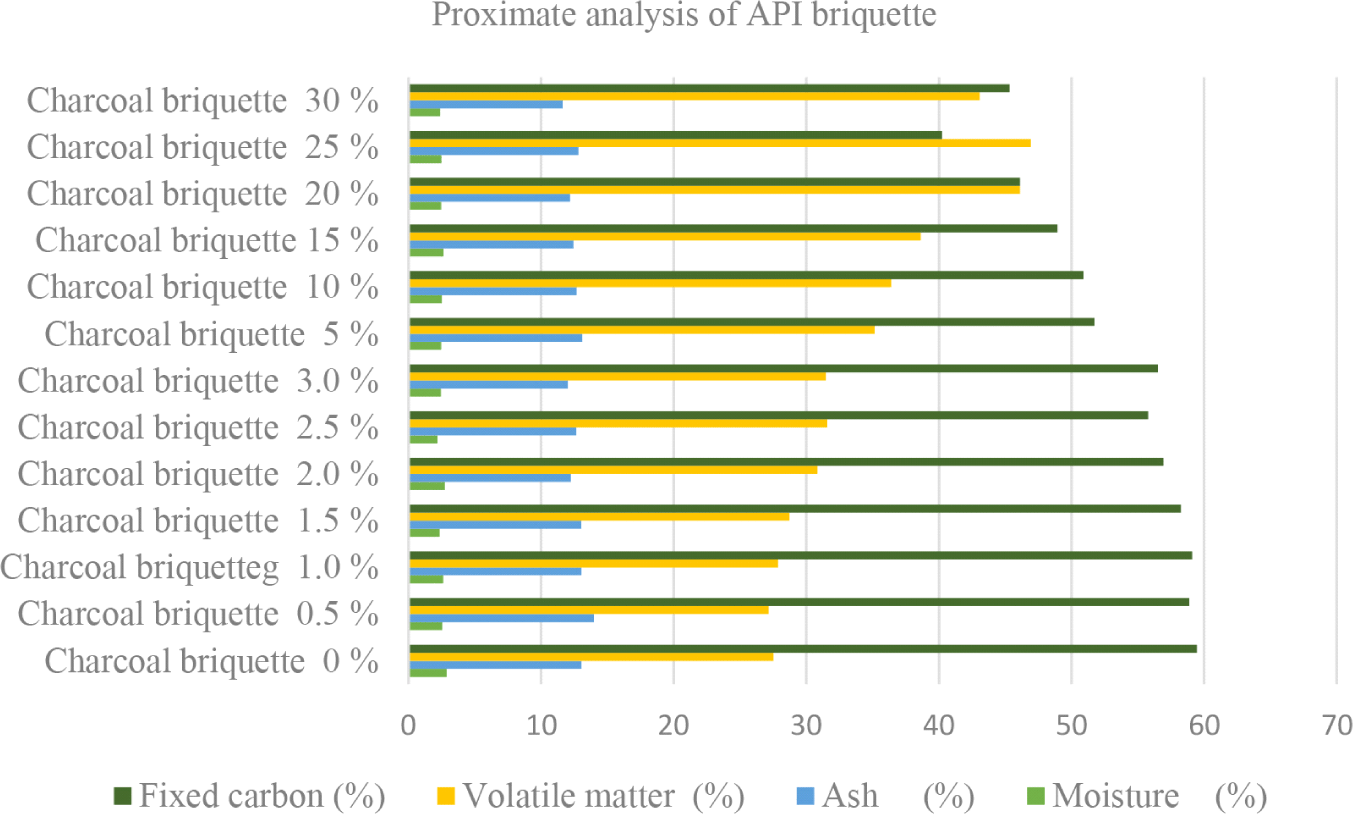
Briquette products with 0%–30% pine resin have an ash content of 11.61%–13.98%, which exceed the ash content required by SNI. Similarly, their volatile matter content, which is 27%–46%, exceeds the SNI requirement of < 15%. High amounts of ash and volatile matter can affect the fixed carbon content and the quality of briquette products. In this study, the fixed carbon content of briquette products is 40.24%–59.46%. The results of this study are more significant than those of the research on empty palm fruit bunch briquettes (moisture content, > 8%; volatile matter content, 70%–80%; fixed carbon content, 4%–15%; and calorific value, approximately 4,000 kcal/kg; Nyakuma et al., 2014). Charcoal briquettes from Kepok banana peel waste have a low fixed carbon content, ranging 13%–16% (Rahmawati et al., 2022). These results agree with previous studies where the conventional burning of charcoal using a stove or drum kiln tend to require a long burning time and yield products with low carbon and carbon dioxide contents (Homchat and Ramphueiphad, 2022). However, previous research has found that the calorific value of charcoal produced using traditional kiln processes is higher than that of charcoal produced using modified kilns (Kwon et al., 2018). Wood charcoal briquettes also have carbon, ash, volatile matter, and moisture contents of 25%, 3.85%, 40.5%, and 4.4%, respectively; their calorific value reaches 8,300 kcal/kg (Nagarajan and Prakash, 2021). Generally, a high ash content is accompanied by a low calorific value and inadequate fuel quality (Ju et al., 2020a). However, this does not apply to the present study because the calorific value obtained is relatively high. According to the study of Tumutegyereize et al. (2016), the calorific value and ash content also depend on the composition of raw materials.
A high fixed carbon content results in high energy and calorific values (Jeoung et al., 2020). However, despite the low fixed carbon content in this study, the calorific value as a measure of briquette energy is relatively high, ranging 5,338–6,120 kcal/kg. Physical and chemical properties, such as moisture content and adhesive properties, affect the heating rate of briquettes. The lower the moisture content, the more efficient the briquette product because of its low specific heat capacity. Adhesives/binders tend to increase the moisture, ash, and volatile matter contents and reduce the calorific value compared with pure charcoal (Kumar et al., 2021).
As mentioned, in the analysis of API briquette, the calorific value is relatively high, 5,338–6,120 kcal/kg (Fig. 2). The minimum calorific value based on the SNI is 5,000 kcal/kg. However, the calorific value of API briquettes is lower than that of starch briquettes with molasses as an adhesive, ranging 6,400–6,800 kcal/kg (Rahman et al., 2022). For comparison, the standard values for Japanese, British, and American briquettes are 6,000–7,000, 7,000, and 6,200 kcal/kg, respectively. The calorific value of coal briquettes also tends to be high, ranging 4,300–7,500 kcal/kg; however, the combustion of these briquettes produces particulate compounds that are harmful to humans (Shao et al., 2016).
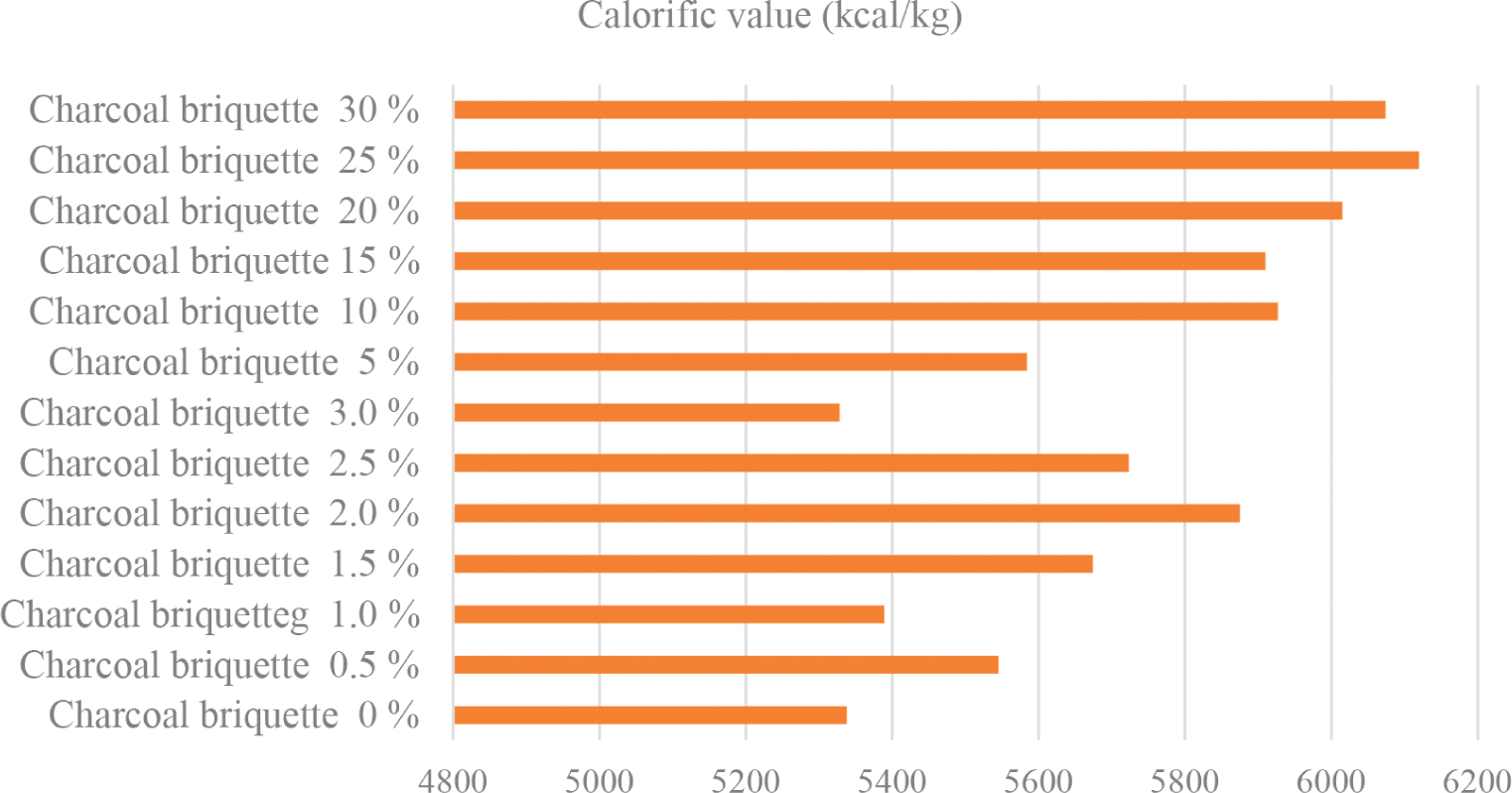
The compressive strength of API briquettes is also examined. The compressive strength ranges 186–540 kg/cm2. When more pine resin is added to the briquettes (reaching 5%), the compressive strength increases to an optimal value (Fig. 3).
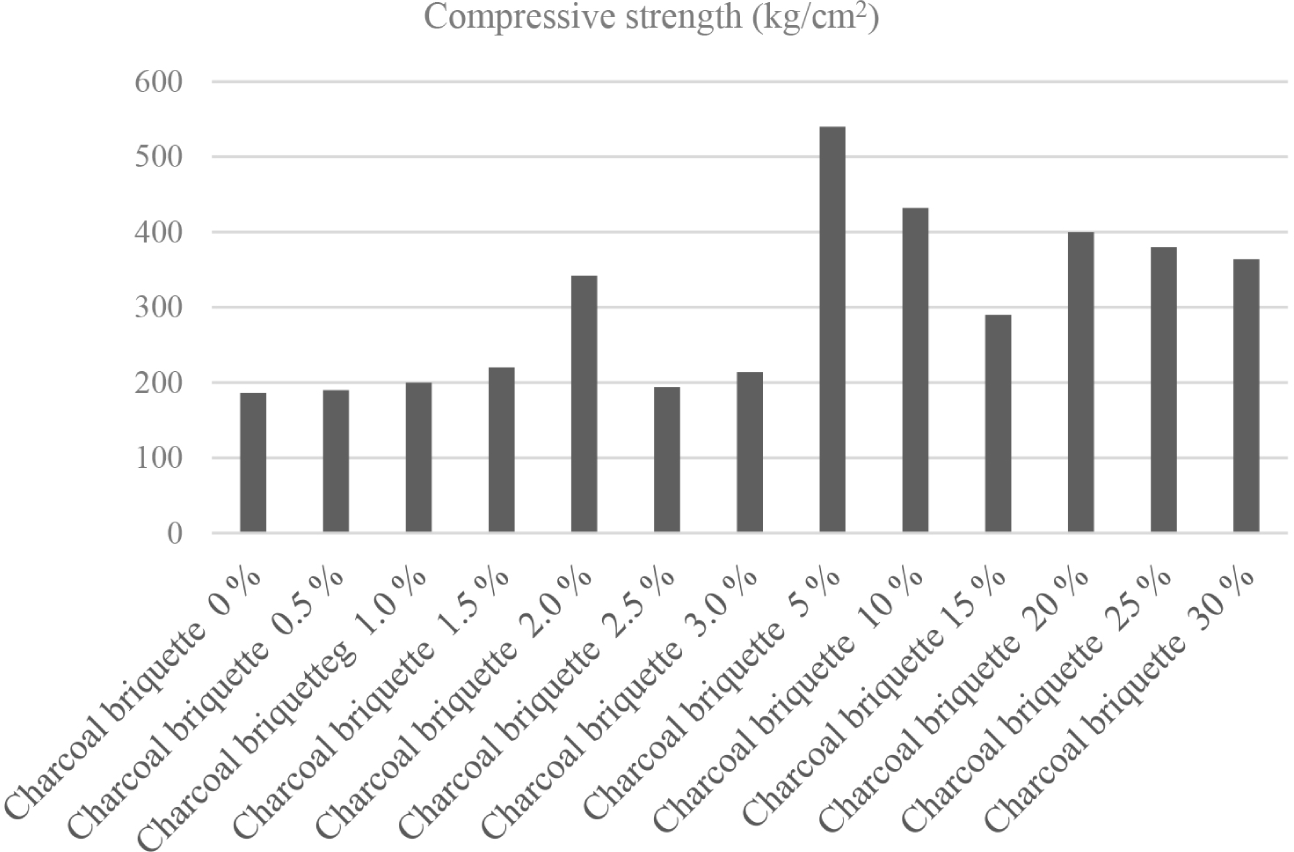
The use of charcoal tends to increase the resistance and compressive strength; however, at specific concentrations, these properties decrease. This agrees with the research result of Phonphuak where the use of 70%–95% charcoal increases the compressive strength to 152 kg/m3; the compressive strength decreases with increasing charcoal concentration (Phonphuak and Thiansem, 2012). The decrease in compressive strength tends to be inversely proportional to the reductions in density and moisture content. Strength properties are known to be affected by many aspects, such as moisture content, specific gravity, and others internal factors (Kim et al., 2020). Density increases when the charcoal content is high, ranging 97%–99.5%. The binder type, concentration, and compacting pressure significantly affect the compaction and compressive strength of briquettes (Aransiola et al., 2019).
The carbonization process of biomass decomposes lignin compounds; therefore, adhesives/binders must be added to increase the compressive strength of charcoal briquettes for transportation and other uses. The selection of the adhesive, adhesive concentration, and compression pressure must be considered during briquette production. Excessively high pressure in the molding process tends to cause charcoal expansion and cracking. This collapses the structure among charcoal powders and destroys the briquette structure although the volume remains the same. However, the compressive strength decreases (Guo et al., 2020).
In the densification process, water plays an essential role in gluing and lubrication; hence, the strength of the briquette product increases as the water content increases to an optimum point (Wu et al., 2018). The density tends to be high when the concentration of pine resin is less than 5% (Fig. 4). The density must be high because tight briquettes do not readily absorb water and are expected to be strong. The foregoing agrees with the research results of Zhang et al. (2018). They found that the compressive strength was influenced by density, especially when hot pressing was used in the production. In this study, the briquette products are composed of CS charcoal and pine resin combined by a starch adhesive prepared as previously described. The thickness and diameter of the API briquettes reach 2 and 3.5 cm, respectively (Fig. 5). The figure indicates an interesting data pattern. The calorific value drops with 3% pine resin addition due to the ash content. Moreover, carbon is not fully generated because a traditional kiln is used. A high amount of added pine resin (i.e., exceeding 3%) reduces the charcoal composition. The reduced composition decreases the briquette density because the density of CS charcoal exceeds that of pine resin. However, the addition of pine resin can increase the compressive strength because the pine resin glues the charcoal during the formation of briquettes, rendering the products more compact.
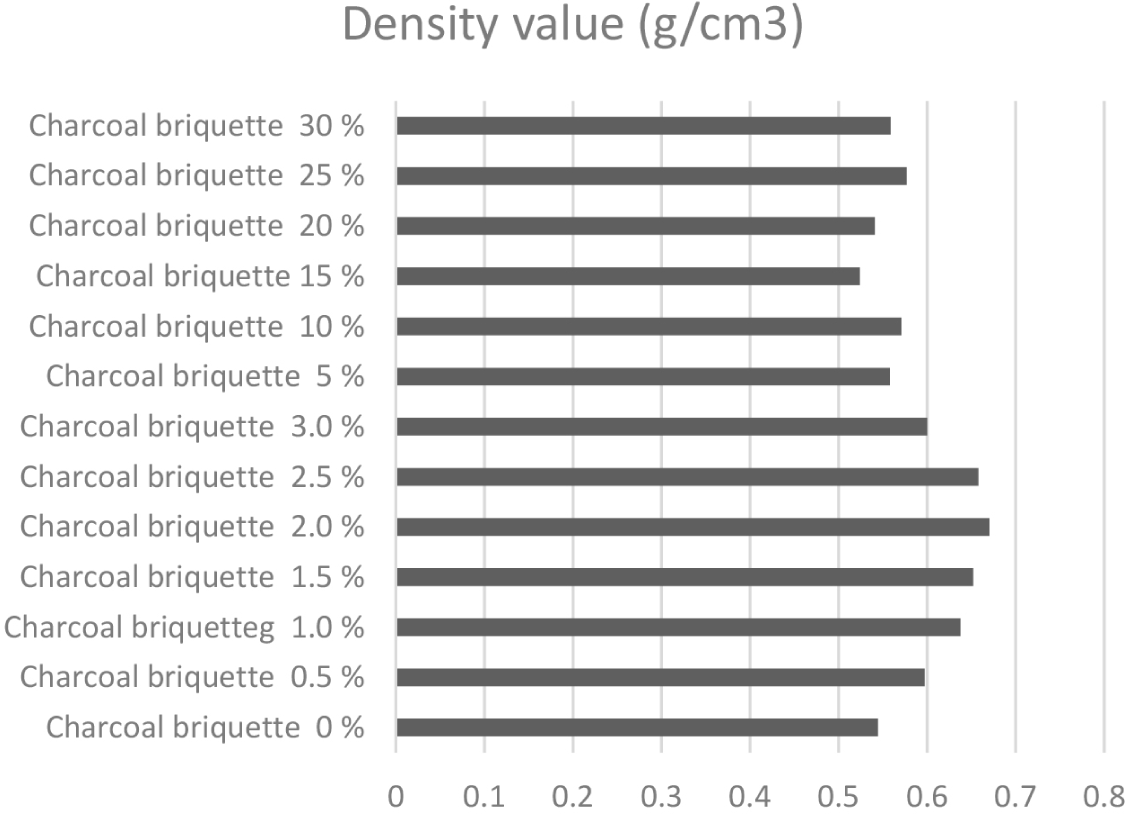
Furthermore, the addition of pine resin at 0.5% intervals resulted in optimum values of compressive strength and density in the briquette with 2% charcoal. The addition of 2.5%–3.0% pine resin can decrease the briquette density owing to the reduced charcoal component. A bond synergy between charcoal and resin is observed in briquettes with 2% pine resin, thus improving compressive strength. The compressive strength significantly increases with resin addition at 0.5% intervals. The increase in adhesive strength results from the bond between the charcoal and resin.
Pine resin is a non-timber forest product widely produced in Indonesia and has considerable utilization potential. The pine resin content also renders the briquette products flavorful and improves ignition strength (Table 1). The pine resin accelerates the burning of the briquettes because it contains flammable turpentine. Rapid burning is required because briquettes are generally difficult to ignite; the combustion speed is directly proportional to the amount of moisture. This study is expected to provide solutions to problems involved in manufacturing excellent briquette products and satisfying the market demand in terms of burning speed and aroma, which can provide health benefits to briquette users.
Table 1 indicates that the API briquettes require a short burn-out time. These data follow Tumutegyereize’s research in which briquettes with pure charcoal are relatively quicker to burn than briquettes with additional ingredients, such as soil (Tumutegyereize et al., 2016). This condition is also related to the ash content, which can block the radiant heat transfer in the briquettes. Ju et al. (2020b) found that agglomerated charcoal with ignition agents tends to have a shorter ignition time than charcoal. To obtain high-quality briquettes, a pretreatment process is necessary such that the compressive strength characteristics can be improved, the heating value can be increased, and the ash content of the briquettes can be decreased (Wu et al., 2018). The charcoal from CSs can be further processed into activated charcoal to obtain high fixed carbon content and calorific value, whereas the ash and volatile matter contents have low values (Efiyanti et al., 2022). The heating value depends on the carbon–oxygen content ratio, generally following the pattern lignin > cellulose > hemicellulose > extractive > ash. To investigate the chemical composition of the API briquette, the authors analyzed the py-GC-MS results of briquettes, pine resins, and API briquettes. Data are summarized in Tables 2, 3, and 4.
Table 2 indicates that the charcoal briquette contains several chemical compounds, such as methoxy naphthalene, phenol, benzopyrrole, and lauryl alcohol, with relative concentrations of 1.28, 5.78, 2.56, and 0.41, respectively. These chemical compounds have both advantages and disadvantages. Lauryl alcohol, which includes organic compounds, is a fatty alcohol. It is typically used for cleansing and as an emollient. This alcohol, also known as indole, has a pleasant fragrance and is colorless. The chemical compounds in the pine resin are listed in Table 3.
Table 3 indicates that pine resin contains several compounds, ocimene, valencene, and cembrene, which are used for fragmentation. Valencene has a citrus fruit scent, ocimene has a sweet and herbaceous scent, pinene has a menthol flavor, and cembrene has an anti-acne property (Chen et al., 2020; Sukarno et al., 2020). Bhagat et al. (2018) reported that essential oils derived from pine containing longifene, pinene, cymene, terpinene, and other compounds had potential antibacterial, antifungal, anti-inflammatory, hepatoprotective, and antioxidant properties. Because the API briquette is produced using a combination of CS charcoal and pine resin, the resulting chemical compounds are from both components (Table 3).
Table 4 indicates that the API briquette contains several chemical compounds that can be used as aromatics or fragrances, including musk ambrette, ocimene, sabinene, and limonene. Methyl abietate, a natural product of pine resin, is also present in API briquettes. This compound is typically used as a solvent and fragrance agent. Another compound, 1-(p-Ccumenyl) adamantane, is generally used for polymeric materials and drug application (Ameh, 2015).
The most important compounds are those reported to be flammable and typically used as fuels, such as butane and propanal. This compound is advantageous for the rapid combustion of briquette products. With appropriate technology, pine resin can increase product value. In this study, unprocessed resin is used to improve the quality of charcoal briquettes. Unprocessed resin is inexpensive compared with utilizing processed pine resins. Pine resin not only shortens the combustion time but also increases the calorific value of API briquettes. Moreover, its aroma has a therapeutic function, which is another advantage of these briquettes. Therefore, the value of API briquettes is considerably increased despite the increase in production cost. This study demonstrates that API briquettes can be produced using CS charcoal and pine resin with starch as adhesive. The overall results further show that API briquettes are an alternative energy source and can be used as aromatherapy, thus supporting green technology and clean energy.
4. CONCLUSIONS
The thickness and diameter of the API briquettes produced in this study are up to 2 and 3.5 cm, respectively. Their moisture, ash, volatile matter, and fixed carbon contents are 2.18%–2.62%, 11.61%–13.98%, 27.15%–51.74%, and 40.24%–59.46%, respectively. The compressive strength and heating value of the briquettes are 186–540 kg/cm2 and 5,338–6,120 kcal/kg, respectively, with high-speed ignition occurring within 0.15–0.40 s. Briquettes with pine resin have considerable potential as alternative energy source and aromatherapy to support green technology and clean energy. For sustainable charcoal briquette production and raw material supply (especially in developing countries, such as Indonesia), policies and regulations regarding the foregoing must be formulated. One such regulation pertains to planting, regenerating, and selecting plant species for charcoal and briquette raw materials. The use of biomass can reduce the amount of carbon dioxide discharged to the environment and provide incentives to users of renewable energy.

